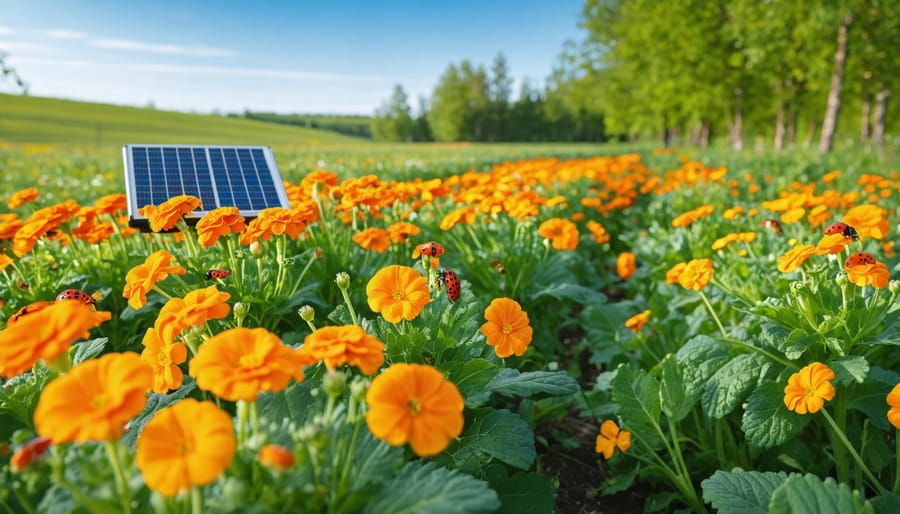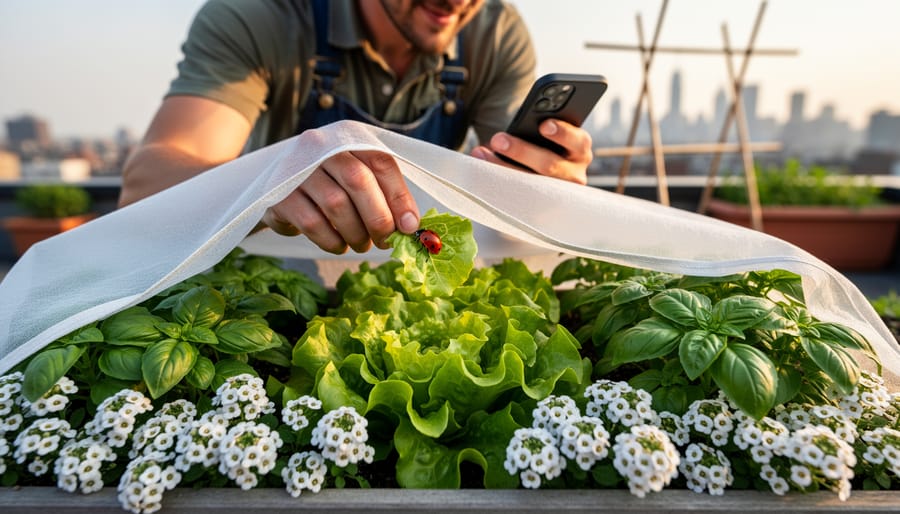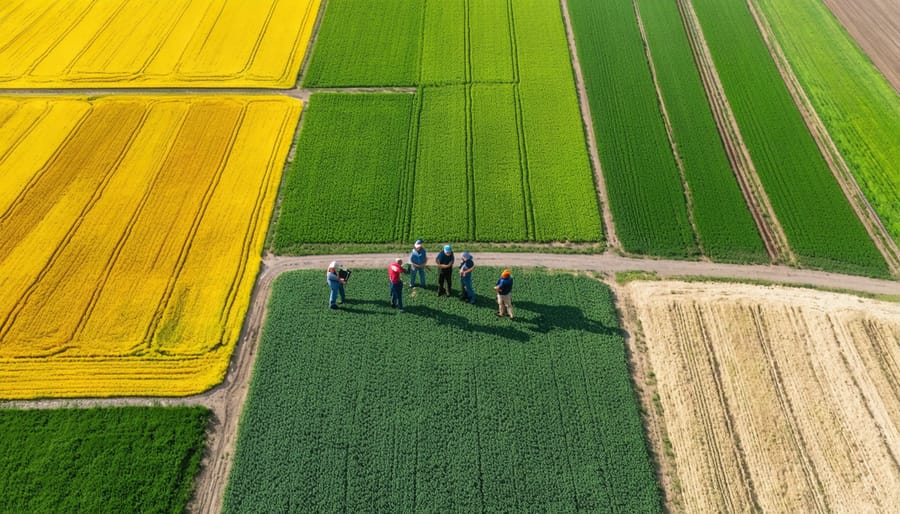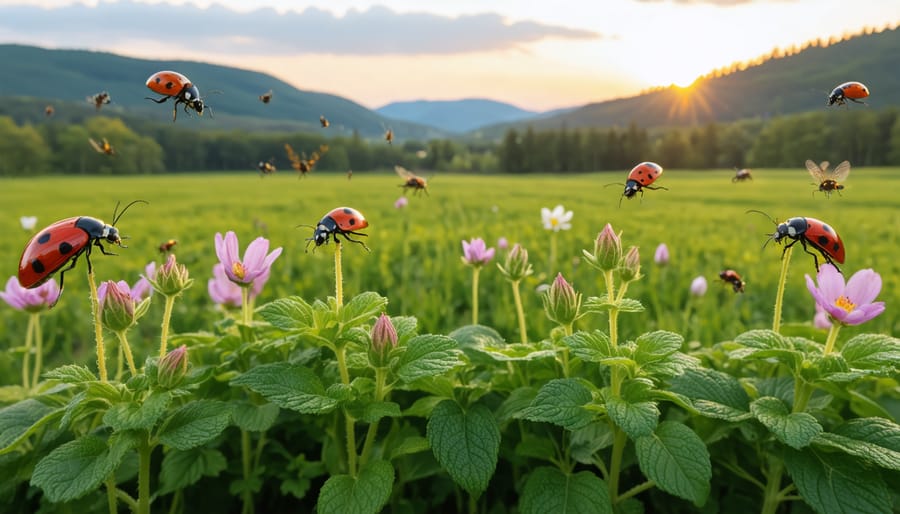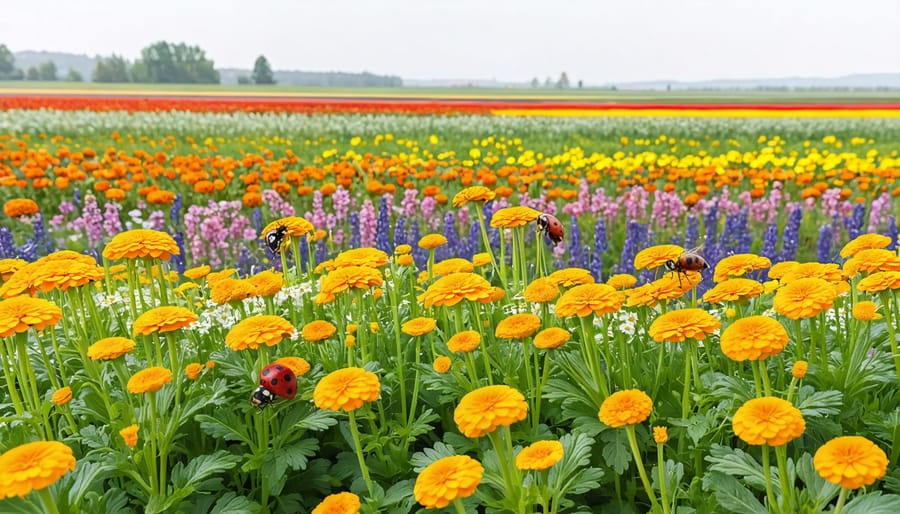Transform your farm’s pest control strategy with proven chemical-free pest management solutions that work in Alberta’s unique climate. Deploy predatory nematodes to combat root-feeding insects, achieving 70% reduction in pest populations within one growing season. Integrate companion planting using marigolds and nasturtiums around field perimeters, creating natural barriers that repel common agricultural pests while attracting beneficial insects. Install solar-powered ultrasonic devices strategically throughout your fields – these units effectively deter rodents across 2-hectare zones while consuming minimal energy.
Canadian farmers implementing these eco-friendly methods report 40% lower pest management costs compared to conventional chemical treatments, while maintaining or improving crop yields. These solutions work particularly well in our prairie growing conditions, where temperature fluctuations and short growing seasons demand robust, adaptable pest control strategies. By choosing environmentally conscious options, producers protect beneficial soil microorganisms, support native pollinator populations, and maintain the long-term health of their agricultural operations.
Nature’s Arsenal: Proven Biological Control Methods
Beneficial Insects That Thrive in Alberta
Alberta’s unique ecosystem supports a diverse range of beneficial insects that naturally help control pest populations. Ladybugs, particularly the native Seven-spotted species, are voracious aphid predators, consuming up to 5,000 aphids during their lifetime. Green lacewings, often called “aphid lions,” patrol crops at night, effectively managing soft-bodied pests while complementing modern pest monitoring techniques.
Ground beetles, abundant in our prairie soils, provide excellent control of cutworms and other ground-dwelling pests. Parasitic wasps, including the tiny Trichogramma species, naturally control moth eggs and caterpillars in various crops. These beneficial insects thrive when farmers maintain diverse field margins and hedgerows.
To attract and maintain these helpful allies, consider planting companion flowers like yarrow, dill, and native asters. These plants provide nectar and pollen throughout the growing season. Creating overwintering sites with mulch and maintaining uncultivated areas helps ensure these beneficial insects return year after year.
Reducing broad-spectrum pesticide use and implementing buffer zones around field edges significantly increases beneficial insect populations. Many Alberta farmers have successfully integrated these practices, reporting improved pest control while reducing chemical inputs. Remember, healthy populations of these insects can provide natural pest control equivalent to several chemical applications per season.

Companion Planting Strategies
In Alberta’s diverse agricultural landscape, strategic companion planting has proven to be one of our most effective natural pest control methods. When properly implemented, these plant partnerships create a robust defense system against common crop pests while promoting overall soil health.
For grain farmers, planting strips of aromatic herbs like dill and fennel between wheat rows has shown remarkable success in deterring aphids and wheat mites. Many Alberta farmers have reported up to 40% reduction in pest damage using this technique. Marigolds, particularly French marigolds, are excellent companions for most vegetables, as their strong scent naturally repels nematodes and other soil-dwelling pests.
For market gardeners, the “Three Sisters” method – combining corn, climbing beans, and squash – remains a time-tested approach. The corn provides support for beans, while squash spreads along the ground, creating natural mulch that prevents weed growth and deters pest insects.
Garlic and onions are particularly valuable companion plants in our climate. When planted around the perimeter of cole crops like cabbage and broccoli, they effectively deter cabbage moths and other brassica pests. Local farmers have found success planting lavender and rosemary near their fruit trees, as these herbs naturally repel many orchard pests while attracting beneficial pollinators.
Remember to consider plant spacing and soil requirements when implementing these combinations. A successful companion planting strategy should work with your existing crop rotation plan and local growing conditions.
Plant-Based Solutions That Handle Prairie Pests

Essential Oil Formulations
Essential oils have emerged as powerful tools in natural pest control strategies, with several locally available options proving effective in Alberta’s farming conditions. Peppermint oil has shown remarkable success in deterring aphids and spider mites, while cedarwood oil effectively manages grain storage pests. Local farmers report particular success with lavender oil for controlling cabbage moths and carrot flies.
For optimal results, blend 15-20 drops of essential oil with 1 litre of water and a small amount of natural emulsifier like castile soap. This mixture can be applied using standard spraying equipment during early morning or late evening hours for best results. Rotation between different oils helps prevent pest resistance and enhances overall effectiveness.
Popular combinations among Alberta farmers include:
– Peppermint and rosemary (2:1 ratio) for field crop protection
– Thyme and clove (1:1 ratio) for greenhouse applications
– Eucalyptus and tea tree (3:1 ratio) for storage facility treatment
When sourcing essential oils, consider local suppliers who understand agricultural applications. The Rocky Mountain Essential Oil Cooperative, based in central Alberta, provides bulk quantities specifically formulated for farm use. Remember that essential oils break down naturally, requiring regular reapplication every 7-10 days during peak pest seasons.
For best practices, conduct small-scale trials on test plots before widespread application, and always monitor weather conditions to maximize effectiveness and minimize waste.
Herbal Sprays and Deterrents
Natural herbal sprays and deterrents offer Canadian farmers an effective, environmentally conscious approach to pest management. These solutions harness the power of locally available plants and essential oils to protect crops while maintaining soil health.
Popular DIY herbal sprays include garlic and hot pepper solutions, which have shown promising results in deterring common Alberta crop pests. To create a basic garlic spray, blend 4-5 cloves with 500ml of water and strain. For enhanced effectiveness, add 1-2 drops of liquid soap as an emulsifier. Many Alberta farmers report success using this mixture for controlling aphids and small insects.
Commercial herbal products available in Canada increasingly feature ingredients like neem oil, pyrethrum (from chrysanthemums), and cedar oil. These formulations are particularly effective against grasshoppers and beetles common to Prairie regions. Local farmer Sarah Thompson from Lethbridge notes, “We’ve been using neem-based sprays on our vegetable crops for three seasons now, and we’ve seen a 40% reduction in pest damage without compromising beneficial insect populations.”
Essential oil blends containing peppermint, lavender, and eucalyptus have proven especially useful for greenhouse operations. These can be mixed with water at a ratio of 15-20 drops per litre for an effective spray. Remember to test any new solution on a small area first, as some plants may be sensitive to certain oils.
For best results, apply herbal deterrents during dry weather conditions and reapply after rainfall. Many farmers combine these sprays with companion planting strategies for comprehensive pest management.
Mineral-Based Products That Work in Our Climate
Diatomaceous Earth Applications
Diatomaceous earth (DE) offers Alberta farmers an effective and natural way to control pests across various crops. When applying DE, timing and method are crucial for optimal results. For field crops, apply during early morning or evening when dew provides slight moisture for better adhesion. Use a mechanical duster or spreader to distribute 2-4 kg per hectare, ensuring even coverage across the plant surfaces.
For greenhouse applications, use a handheld duster to apply a fine layer on plant leaves, focusing on both upper and lower surfaces. Reapplication is necessary after heavy rain or irrigation. In grain storage, dust the bottom and sides of bins with 500g per 100 square metres before filling, then apply a protective layer on top of the grain.
Local farmer Mike Thompson from Leduc County shares, “We’ve successfully used DE on our organic wheat fields for three seasons now. The key is consistent application and monitoring weather conditions.”
Remember that DE works through physical rather than chemical action, making it safe for beneficial insects once settled. For best results in our prairie climate, apply when humidity levels are below 65% and avoid application during windy conditions. Create barriers around garden beds and greenhouses by applying a 5cm wide band of DE at the base of plants.
Always wear appropriate respiratory protection during application, as the fine dust can be irritating when airborne. For certified organic operations, ensure your DE source is approved by your certifying body.
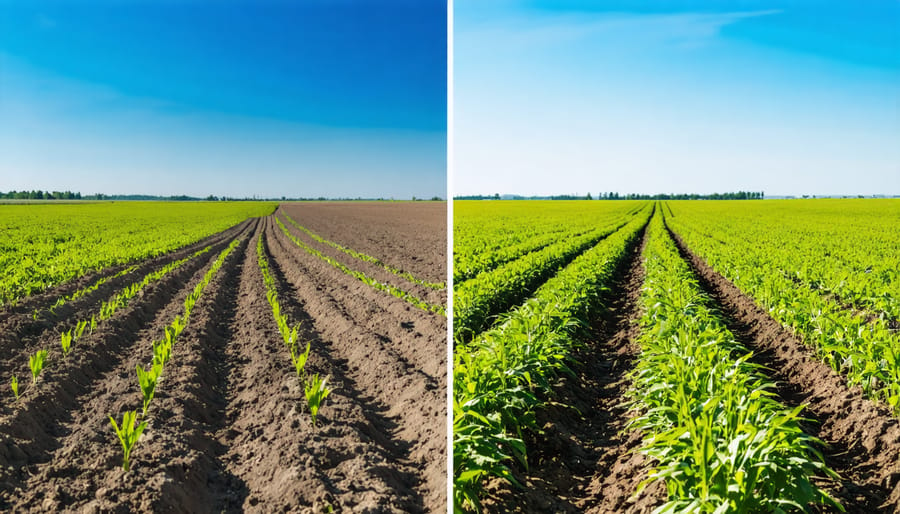
Kaolin Clay Solutions
Kaolin clay has emerged as a game-changer for Alberta farmers seeking sustainable pest control solutions. This fine, white mineral creates a protective barrier on plants that deters insects while remaining completely safe for the environment. When properly applied, it forms a thin film that irritates insects and disrupts their feeding patterns.
For optimal results in our prairie climate, mix 3-6 kilograms of kaolin clay per 100 litres of water. Application should occur during dry conditions, ideally in the early morning when dew has evaporated. The solution needs reapplication after significant rainfall or every 7-14 days during peak pest seasons.
Local farmer Sarah Thompson from Lacombe County reports, “We’ve seen a 40% reduction in flea beetle damage on our canola crops since switching to kaolin clay sprays. It’s particularly effective during the vulnerable seedling stage.”
The clay solution works best when applied preventatively, before pest populations peak. For vegetable crops, ensure thorough coverage on both upper and lower leaf surfaces. Root crops benefit from early-season applications to prevent pest establishment.
While highly effective, kaolin clay requires careful timing and monitoring. Some Alberta farmers combine it with companion planting for enhanced protection. The white residue may need washing from harvested produce, though rainfall typically removes it naturally. This solution proves particularly valuable for organic operations and farms transitioning to sustainable practices.
Real Results: Alberta Farm Case Studies
Alberta’s farming community has embraced eco-friendly pest control solutions with remarkable results, as demonstrated by several inspiring pest management success stories across the province.
Take the Morrison Family Farm in Lacombe County, which switched to beneficial insect releases three years ago. Sarah Morrison reports a 40% reduction in pesticide use while maintaining crop yields. “We introduced ladybugs and parasitic wasps to control aphids in our canola fields,” she explains. “The initial investment was higher, but we’ve saved significantly on chemical inputs since then.”
In Lethbridge, the Peterson Brothers’ organic grain operation demonstrates the power of companion planting. By integrating dill and yarrow around their field perimeters, they’ve created natural barriers that repel harmful insects while attracting beneficial ones. Their documented results show a 35% decrease in pest-related crop damage compared to previous conventional methods.
The Cedar Creek Greenhouse operation near Red Deer presents another compelling case. Owner James Thompson implemented a comprehensive IPM (Integrated Pest Management) system using sticky traps, biological controls, and strategic crop rotation. “We’ve eliminated synthetic pesticides entirely,” Thompson notes, “and our tomato yields have actually increased by 15% over the past two seasons.”
Perhaps most notably, the collective effort of five farms in the Peace River region shows how community-based approaches can amplify results. These farms collaborated to create insect-friendly corridors between their properties, sharing resources and knowledge. Their combined data shows a 50% reduction in pest-related losses while cutting pest control costs by nearly a third.
These success stories highlight that eco-friendly pest control isn’t just environmentally responsible – it’s economically viable. The initial transition period typically requires patience and careful monitoring, but the long-term benefits to soil health, biodiversity, and the bottom line make it a worthwhile investment for Alberta farmers.
As we’ve explored throughout this guide, implementing eco-friendly pest control products isn’t just an environmental choice – it’s a smart business decision for Canadian farmers. By adopting these sustainable solutions, you’re not only protecting your crops but also preserving the rich agricultural heritage of Alberta and beyond.
Remember that successful implementation starts with thorough planning and careful product selection. Begin with a comprehensive pest assessment of your land, then gradually introduce natural predators and biological controls. Start small with trial areas before scaling up across your entire operation, and don’t hesitate to connect with local agricultural extension services for guidance.
The transition to eco-friendly pest control might require some initial adjustments, but the long-term benefits – including improved soil health, reduced chemical residues, and stronger market appeal – make it well worth the effort. Many of your fellow Alberta farmers have already seen success with these methods, reporting better crop resilience and increased profitability.
Take advantage of available resources and support networks. Connect with other farmers in your region who have made the switch, attend workshops offered by local agricultural organizations, and stay informed about new sustainable pest control developments. By working together and sharing experiences, we can build a more sustainable future for Canadian agriculture.
Your next step? Choose one eco-friendly pest control method from this guide and implement it this growing season. Start small, document your results, and build upon your successes.

